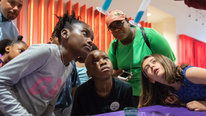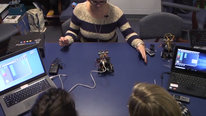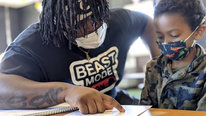- Erin Krupa
- https://erinkrupa.wordpress.ncsu.edu/
- Assistant Professor
- Innovation Challenges for Middle School Mathematics in a Digital Learning System: Student Participation Impact on Achievement, Affect, and STEM Career Interest
- https://sites.ced.ncsu.edu/design-and-pitch/
- North Carolina State University
- Michael Belcher
- Research Associate
- Innovation Challenges for Middle School Mathematics in a Digital Learning System: Student Participation Impact on Achievement, Affect, and STEM Career Interest
- https://sites.ced.ncsu.edu/design-and-pitch/
- North Carolina State University
- Josh Mannix
- Graduate Research Assistant
- Innovation Challenges for Middle School Mathematics in a Digital Learning System: Student Participation Impact on Achievement, Affect, and STEM Career Interest
- https://sites.ced.ncsu.edu/design-and-pitch/
- North Carolina State University
Facilitators’
Choice
Choice
Public Discussion
Continue the discussion of this presentation on the Multiplex. Go to Multiplex









Michael Belcher
Research Associate
Hello!
Thank you for visiting our page and watching our video! We are a team of math education researchers from North Carolina State University. In our video, we talk about our project, the Design & Pitch Challenges in STEM. Under the leadership of Dr. Jere Confrey and Dr. Erin Krupa, we designed these challenges to support rich mathematics learning and promote interest and engagement in STEM, through entrepreneurial pitch competitions. We’ve created nine math-focused STEM design challenges that address authentic entrepreneurial opportunities. Each challenge is launched by a different STEM or entrepreneurial professional and includes connections to real-world applications and STEM careers. Watch the video and let us know what you think! We're excited to hear from you!
Jena Barchas-Lichtenstein
This is really cool. I used to tutor middle-school math, and I had one student who refused to do homework unless I could explain how he'd ever use it again. We're not in touch anymore, and that student must be 25 by now, but I bet their younger self would have LOVED this.
Erin Krupa
Michael Belcher
Research Associate
Hi Jena! Thank you for the kind words! What are some strategies you used to help your middle school tutee see math as useful? This is something I always struggled with as a teacher, which has made entrepreneurship so exciting. The students we talk to all seem to have great ideas for solving real-world problems and entrepreneurship can give them the space to bring those ideas into the math class in a meaningful way. One of our mentors talked about how a key part of entrepreneurship is finding your unique advantage (the opportunity that you are uniquely positioned to address) which allows students to find their purpose for the math. That being said, we're still working on how to best support teachers to implement the challenges and to feel comfortable that they are addressing the standards-aligned math through students' creative solutions. I'd love to learn more about what worked for you and your middle school student!
Jena Barchas-Lichtenstein
Oh, gosh, it was a long time ago!
We talked about money a lot - the example I remember most clearly is that proportions help you figure out which brand is the best deal. We also talked about the day-to-day of a lot of jobs: like a lot of kids that age, they had only a very fuzzy idea about how adults spend their time at work, so hearing how many jobs require different types of calculation was eye-opening for a student who had always found math class painfully abstract. I can see that kid loving this program.
Jessica Hunt
This is such a cool idea and I can clearly see the tie to student engagement and relevance. Engagement and relevance are important for all students and especially important for students who may feel disconnected from more traditional "school mathematics" or whose identity may not include positive perspectives of mathematics. Have you done any research on the impact of students' math identity as related to participation in this work?
Michael Belcher
Research Associate
Hi Jessica! Thank you for commenting on our video!
You raise a great point about students' math identity and students' feeling disconnected from traditional school mathematics. We have not focused explicitly on how participation in the challenges impacts students' math identities, but it would be really interesting to explore and measure. What we have seen that is encouraging is that, because students are drawing on their often unique out-of-school interests in building their solutions, they feel empowered as the experts relative to those solutions and they are excited to explain and defend their thinking, including the math. One of the challenges we have experienced and we continue to work on is how to help students collaborate effectively so that one student is not assigned to do the math while others work on the less mathematical aspects of a challenge. Even in those cases, focusing on the less mathematical aspects can give some students a way to meaningfully contribute to their groups' solutions and, over time, to engage more with the targeted mathematics.
I can't remember, have you explored math identity in your work researching learning disabilities in math? I'd love to learn more about how math identity fits into your work!
Jessica Hunt
Jessica Hunt
I am in the process of partnering with Jonee Wilson to examine how equitable teaching practices can increase participation in conceptually oriented mathematics for students with disabilities and how this may influence theirmath identity. More soon!
Erin Krupa
Candace Walkington
This is really interesting work, thank you for sharing it! I love how you are embedding math in real world contexts that students care about and become invested in, and that they can apply their everyday knowledge to. One thing I wondered watching your video, and thinking about research on PBL, is how to scaffold students using particular math concepts when formulating their pitches and doing all the background work. Are there particular math standards that you are seeking to cover? If so, how to you make sure that students are covering the math concepts you want to cover? Also, are there ways that the teacher or the curriculum tries to highlight the relevant math concepts, so that they don't get lost in all the other kinds of activities going on?
Erin Krupa
Michael Belcher
Research Associate
Hi Candace, these are great questions! The challenges are aligned to specific common core math standards and you are absolutely right about the importance of scaffolding students' work and drawing their attention to the standards-aligned math they are doing. We've gone about this in a few ways. First, each challenge includes design criteria that drive back at the targeted math and that must be addressed in a successful solution. Second, each challenge includes a set of resources designed to jump-start student thinking and support their mathematical reasoning. So, for example, the Building Algorithms challenge includes examples of real-world rating/ranking algorithms (e.g., in the Madden football video game), as well as a spreadsheet resource that helps students learn what an algorithm is and learn the symbolic language and syntax needed to write a spreadsheet formula, which is the heart of the math that the challenge is driving at. Everything on our site is student-facing, so students can access these resources independently or teachers can conduct small-group workshops to help students engage with the content. Lastly, each challenge includes a technical brief, in which students reflect on their design process and describe/justify the specifics of their solutions. The tech brief is the more "schooly" side of the challenges and we're still trying to figure out how to best introduce it. We've had the most success using it as an opportunity for students to reflect and for the teacher to return to after the pitch to formalize mathematical thinking. This is something we are continuing to work on.
In terms of pitching, we bring in and encourage teachers to bring in external judges. We supply a rubric which evaluates teams on the quality of their pitch and the viability and creativity of their solution from an entrepreneurial angle. We want the pitches to be about their product/business and not get overly focused on explaining the math to help students perceive it as an authentic activity. We include a student-facing rubric for the teacher to evaluate the math. That being said, our model also has teachers continually checking-in with teams and focus specifically on the design criteria and the math. The goal is to frame our math questions in the context of students' solutions. I hope this helps. I would love to talk more about how your project grapples with some of these issues! One of our biggest and most fun challenges has been identifying problems that are authentic but also accessible for middle school math. It seems like you've done a really nice job with this!
Holly Morin
Fascinating!! Love this idea! I think where the teacher highlights the cross-disciplinary nature of this activity is key, and that students actually see a real-world scenario/process through from start to finish. There is honestly SO much students could glean from an activity such as this! Did you capture any of that (student feedback as to what they learned?) I am also curious, who voted for the winners and what type of criteria were projects being judged on? Thank you for sharing!!
Erin Krupa
Heidi Carlone
Distinguished Professor
Great ideas for a way to engage students in rich design thinking and authentic mathematics. What kinds of data are you collecting to evaluate the nature of students' mathematical learning, thinking, and engagement? What kind of professional learning are teachers engaged in to enact the project? Do they have opportunities to share knowledge across schools/sites? Thanks for sharing the project!
Erin Krupa
Michael Belcher
Research Associate
Hi Holly! Thank you for the kind words! You're absolutely right that how the teacher highlights/supports the cross-disciplinary connections is key and it's something we are continually working on. As math educators, it's easy for us to get overly focused on the math. When we talk to students, they often talk about learning to design a business or an app or build an algorithm. When we ask about the math, they try to find where they carried out calculations, ignoring that they wrote symbolic spreadsheet formulas or built hypothetical data representations (for example). So, that has been a struggle for us - making students aware of the rich math they are doing. In terms of the pitch, we recruit and ask teachers to recruit external judges for both the final pitch competition and a practice pitch that we run a day or two before the final competition. These can be community members, parents, members of the school community (e.g., principals or resource teachers), or STEM professionals. We want the judges to be people who are not familiar with students' solutions before the final pitch. It raises the stakes for students when they think the judges know nothing about their solutions and we've seen them rise to the occasion. We ask the judges to use a rubric that focuses on the entrepreneurial viability of the solutions and not the math, as that would not normally be part of an entrepreneurial pitch. We include a rubric for the teacher to assess students' mathematics after the competition. I hope this helps! I'd love to learn more about how, in your work, you help teachers connect the real-world science to curricular goals. Your project is fascinating!
Michael Belcher
Research Associate
Hi Heidi!
Thank you for your kind words! So far, we have been mostly collecting and analyzing qualitative data. These have included video records of teams working on a challenge, participating in practice and final pitches, participating in whole-class discussions, and checking in with teachers/researchers. We've been collecting and analyzing students' work samples, including their key business propositions, tech briefs, pitch decks, and scrap work to understand what mathematics students are using, how they're using it, and how their solutions develop over the course of the study and in relation to the entrepreneurial considerations of the competition. We've also conducted interviews and focus groups with students and teachers during and after competitions to understand both engagement and the development of students' mathematical reasoning. PD has been a challenge for us given the teachers' time constraints and now COVID. We've done a few in-school (pre-COVID) half-day workshops where we ran teachers through a challenge, while discussing how to implement with students. This past summer, we led a week-long virtual offering where we spent more time discussing the model and incorporated opportunities for teachers to anticipate and discuss potential difficulties/concerns. In general, teachers have reported positive perceptions of the PD, but we're still trying to find ways to better support them, especially with connecting students' challenge work back to the standards. As for connecting across sites, that is something that we have not yet found a way to do effectively. We would love to hear ideas for how to create this type of professional learning community. Do you have experience doing this type of work with teachers?
Thank you for participating in the discussion!
Heidi Carlone
Erin Krupa
Assistant Professor
The link to our website is not so obvious on this page, so we want to make sure you know that all of our materials are free and available: https://sites.ced.ncsu.edu/design-and-pitch/ The materials include:
Each Challenge includes: Challenge statement, background resources, key business proposition, pitch resources, tech brief (to show their mathematical thinking and design process), judging sheet, and grading rubric.
Heidi Carlone
Daniel Damelin
Senior Scientist
This idea of engaging students in entrepreneurship to involve them in using math in a way that is important and meaningful for them is genius. I'm curious how this looks in a math classroom. How much time is dedicated to supporting the development of the pitches in class vs. out of class? Do teachers feel pressure to "cover" more topics and so push back on doing projects like this?
Michael Belcher
Research Associate
Hi Daniel! Thank you for the kind words! We don't dictate how much time students should spend outside of school working on the challenges. We offer a few implementation models. These include 6-day and 8-day models where the competition is run entirely in school, with daily benchmarks that correspond to the challenge components, virtual models spread over the course of a week where students work independently (this was a summer model), or one challenge spread across a semester with teachers revisiting the project periodically. Students have mostly completed the full competition in school. It makes the timing tight and we would love it if students spent time outside of school, but so far it's been mostly in-school.
To your other question, you're absolutely right about the pressure to cover topics and this is something that we've heard from teachers as a reason for not using the challenges. So far, we've had the most luck attracting teachers who have more flexibility, whether because they teach elective math courses, STEM courses, or work in an alternative school. As we continue recruiting teachers to use the challenges, we've been trying to find ways to more clearly communicate how the challenges do address the content they need to cover, but that it involves bringing it out of students' solutions. We've done this through showing examples of student products and pitches to help teachers see what students can do and highlighting how those solutions connect to the targeted math content. It's definitely been a struggle. It sounds like you might have encountered this type of pushback before? How would you go about convincing teachers that coverage is not all that matters and that it's important to make space for this type of project?
Daniel Damelin
Senior Scientist
My projects are typically in science classrooms, but we have the same struggles there. To overcome some of the pushback we emphasize that students are not just learning the content but also science practices, like inquiry and modeling. Because those often align with teacher goals, they are willing to push (somewhat) against the urge to cover more content and give some time to more deeply integrate science practices. Not sure if there is something analogous there on the math side, but I suspect there would be.
Michael Belcher
Research Associate
That's a great idea! There are definitely math practices (e.g., modeling, constructing and critiquing arguments, etc.) that we could reference and I think that would resonate with teachers - we do see teachers highlighting these practices in explaining why they think the project is valuable and we probably need to do more to bring these out from the start. One way we tried to bring those out in our materials and in workshops is through our entrepreneurial framework (the spinning wheel in the video), but we could definitely do more to make it clear how the entrepreneurial practices connect to mathematical practices. Thanks for the input!
Dr. Julia V. Clark
Retired Federal Employee
This is an innovative project and an excellent way to make learning activities authentic. The 3-day entrepreneurship competition is an excellent idea way for increasing students interest in math. The students not only engage in real life activities but in interaction with persons who can serve as mentors. Did the students choose the activities and person in which they would like to engage in ? Or were they assigned to them? Do you think 3-days were adequate to accomplish the goal of the project?
Michael Belcher
Research Associate
Hi Dr. Clark! Thank you for your questions! Dr. Confrey came up with the idea for the project after participating in a 3-day competition, but, in adapting it for use in schools, we developed a 6-day model. Even though we really liked the idea of bringing the pressure and excitement of a 3-day model into the classroom, we realized it just would not be enough time for students. We've also developed an 8-day classroom model and a virtual model where students can participate independently (this was a summer model) or teachers can participate with their classes and can choose how much time they spend on the challenge. So far, we think the 6-day and 8-day models are ideal for keeping kids engaged.
To your question about how students choose challenges, our approach has evolved over the course of building the materials. Originally, the plan was to allow each team to choose from the nine challenges - this would be more in line with how real pitch competitions work. However, this made implementation really difficult, as the challenge launch is so important to getting students excited about the competition and helping them to understand the context. Asking teachers to launch multiple challenges at the same time, seemed overwhelming and so we switched to encouraging the teacher to pick one challenge to implement at a time. In terms of the mentors, we should mention that these are videos of mentors. Each challenge includes two videos, one video in which a STEM professional launches the challenge and one in which the same professional gives some background on the context and discusses their experiences in STEM. So, students don't get to do face-to-face interaction with the mentors. Rather, they do it through the supporting videos. It would be great if we could find ways to have greater interaction between mentors and students, though. One way we have tried to do this is through the selection of practice judges and final pitch judges. We've seen schools bring in outside experts to give students feedback on their solutions and in some cases judge the final pitches. Did you have any thoughts on how to support teachers to bring mentors into the classroom for face-to-face interaction? It seems like it would be a great way to get more community involvement in the competitions! Thank you for your thoughtful questions!